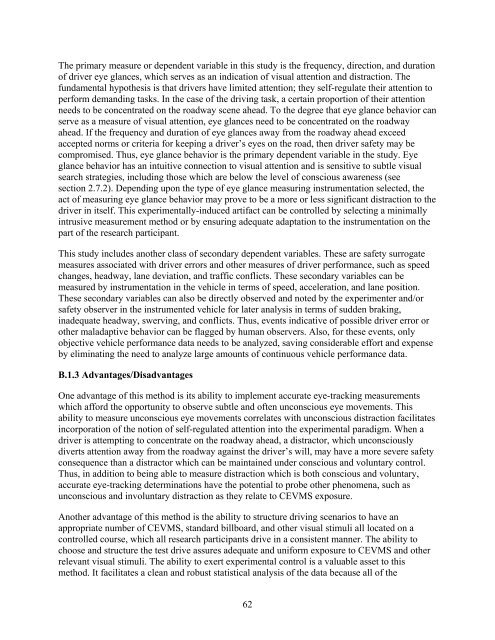The Effects of Commercial Electronic Variable Message Signs ...
The Effects of Commercial Electronic Variable Message Signs ...
The Effects of Commercial Electronic Variable Message Signs ...
You also want an ePaper? Increase the reach of your titles
YUMPU automatically turns print PDFs into web optimized ePapers that Google loves.
<strong>The</strong> primary measure or dependent variable in this study is the frequency, direction, and duration<br />
<strong>of</strong> driver eye glances, which serves as an indication <strong>of</strong> visual attention and distraction. <strong>The</strong><br />
fundamental hypothesis is that drivers have limited attention; they self-regulate their attention to<br />
perform demanding tasks. In the case <strong>of</strong> the driving task, a certain proportion <strong>of</strong> their attention<br />
needs to be concentrated on the roadway scene ahead. To the degree that eye glance behavior can<br />
serve as a measure <strong>of</strong> visual attention, eye glances need to be concentrated on the roadway<br />
ahead. If the frequency and duration <strong>of</strong> eye glances away from the roadway ahead exceed<br />
accepted norms or criteria for keeping a driver’s eyes on the road, then driver safety may be<br />
compromised. Thus, eye glance behavior is the primary dependent variable in the study. Eye<br />
glance behavior has an intuitive connection to visual attention and is sensitive to subtle visual<br />
search strategies, including those which are below the level <strong>of</strong> conscious awareness (see<br />
section 2.7.2). Depending upon the type <strong>of</strong> eye glance measuring instrumentation selected, the<br />
act <strong>of</strong> measuring eye glance behavior may prove to be a more or less significant distraction to the<br />
driver in itself. This experimentally-induced artifact can be controlled by selecting a minimally<br />
intrusive measurement method or by ensuring adequate adaptation to the instrumentation on the<br />
part <strong>of</strong> the research participant.<br />
This study includes another class <strong>of</strong> secondary dependent variables. <strong>The</strong>se are safety surrogate<br />
measures associated with driver errors and other measures <strong>of</strong> driver performance, such as speed<br />
changes, headway, lane deviation, and traffic conflicts. <strong>The</strong>se secondary variables can be<br />
measured by instrumentation in the vehicle in terms <strong>of</strong> speed, acceleration, and lane position.<br />
<strong>The</strong>se secondary variables can also be directly observed and noted by the experimenter and/or<br />
safety observer in the instrumented vehicle for later analysis in terms <strong>of</strong> sudden braking,<br />
inadequate headway, swerving, and conflicts. Thus, events indicative <strong>of</strong> possible driver error or<br />
other maladaptive behavior can be flagged by human observers. Also, for these events, only<br />
objective vehicle performance data needs to be analyzed, saving considerable effort and expense<br />
by eliminating the need to analyze large amounts <strong>of</strong> continuous vehicle performance data.<br />
B.1.3 Advantages/Disadvantages<br />
One advantage <strong>of</strong> this method is its ability to implement accurate eye-tracking measurements<br />
which afford the opportunity to observe subtle and <strong>of</strong>ten unconscious eye movements. This<br />
ability to measure unconscious eye movements correlates with unconscious distraction facilitates<br />
incorporation <strong>of</strong> the notion <strong>of</strong> self-regulated attention into the experimental paradigm. When a<br />
driver is attempting to concentrate on the roadway ahead, a distractor, which unconsciously<br />
diverts attention away from the roadway against the driver’s will, may have a more severe safety<br />
consequence than a distractor which can be maintained under conscious and voluntary control.<br />
Thus, in addition to being able to measure distraction which is both conscious and voluntary,<br />
accurate eye-tracking determinations have the potential to probe other phenomena, such as<br />
unconscious and involuntary distraction as they relate to CEVMS exposure.<br />
Another advantage <strong>of</strong> this method is the ability to structure driving scenarios to have an<br />
appropriate number <strong>of</strong> CEVMS, standard billboard, and other visual stimuli all located on a<br />
controlled course, which all research participants drive in a consistent manner. <strong>The</strong> ability to<br />
choose and structure the test drive assures adequate and uniform exposure to CEVMS and other<br />
relevant visual stimuli. <strong>The</strong> ability to exert experimental control is a valuable asset to this<br />
method. It facilitates a clean and robust statistical analysis <strong>of</strong> the data because all <strong>of</strong> the<br />
62

















